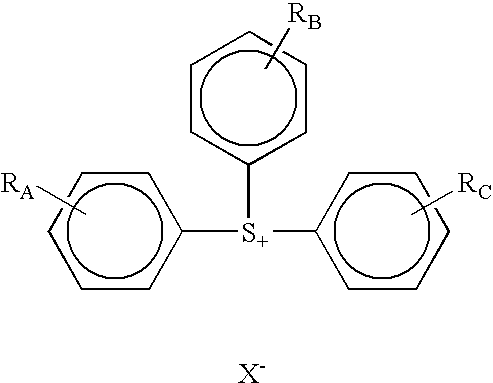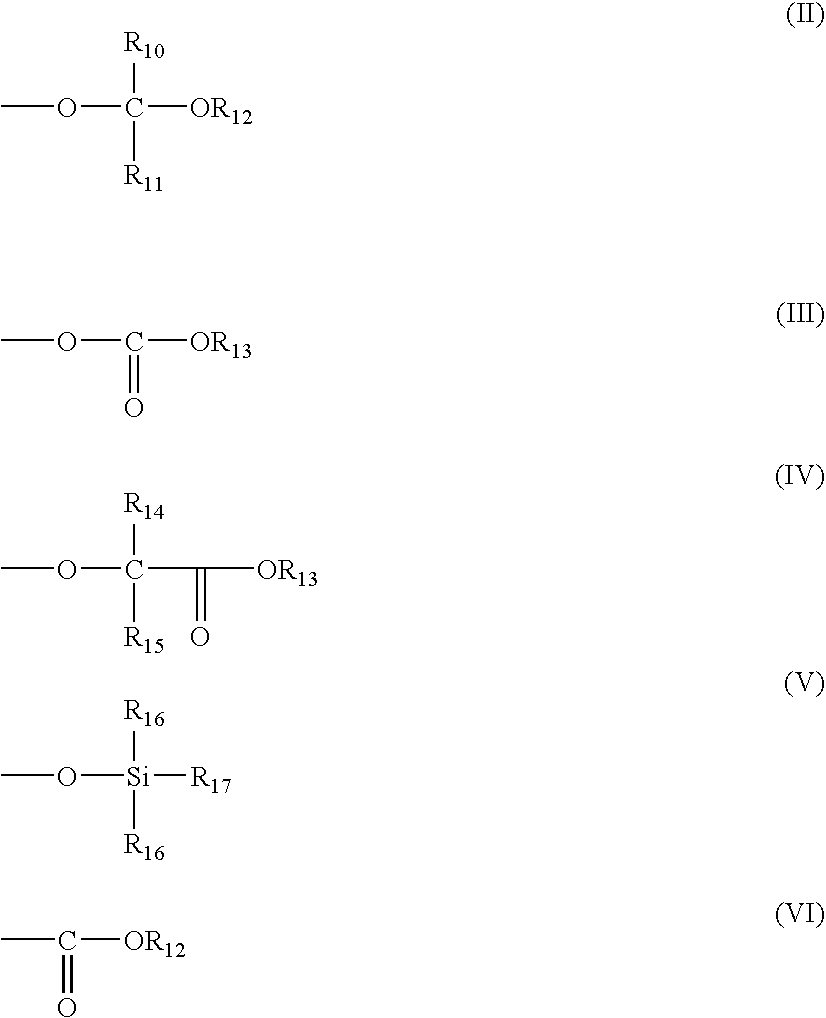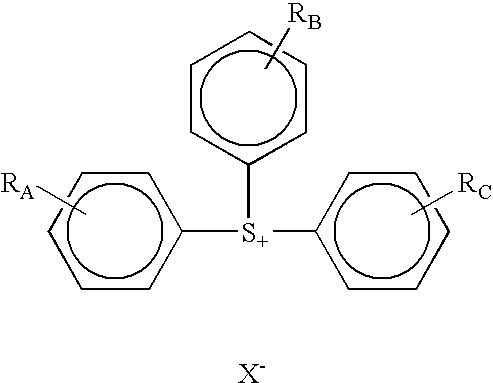Photoactive compounds
a technology of photoactive compounds and compounds, applied in the field of photoactive compounds, can solve the problems of critical roughness of photoresist patterns, adverse effects of edge roughness on the lithographic performance of photoresist,
- Summary
- Abstract
- Description
- Claims
- Application Information
AI Technical Summary
Benefits of technology
Problems solved by technology
Method used
Image
Examples
example 1
Synthesis of bis[4-acetyloxyphenyl]phenylsulfonium perfluorobutanesulfonate
[0076]Bis[4-hydroxylphenyl]phenysulfonium perfluorobutanesulfonate (10 g) and acetone were placed into a reaction vessel equipped with an agitator, a thermometer, a reflux condenser, and a tube for introducing nitrogen gas into the vessel. Under a nitrogen blanket, 4.6 g of potassium carbonate was added to the reaction vessel and the mixture was stirred for an hour. Acetic anhydride 3.43 gram was added and stirred overnight at room temperature. Dichloromethane (150 ml) and water were added to the reaction vessel and the mixture was stirred for 2 hours. The mixture was then placed into a separatory funnel and the organic (dichloromethane) layer was retained. The dichloromethane layer was washed several times with water, dried over anhydrous sodium sulfate, filtered, and the remaining volatile materials were evaporated to leave an oil. Ether was added to the oil and the mixture was stirred vigorously. A very st...
example 2
Synthesis of bis[4-acetyloxyphenyl]phenylsulfonium 4-(1,1,1,2-tetrafluoroethoxy)perfluorobutanesulfonate
[0078]This material was made following Example 1 except bis[4-hydroxyphenyl]phenysulfonium 4-(1,1,1,2-tetrafluoroethoxy)perfluorobutanesulfonate was used instead of bishydroxylphenylphenysulfonium perfluorobutanesulfonate
[0079]
[0080]In addition, the following compounds can be made following the procedure in Example 2 using the corresponding anion:
[0081][0082]Example 2a: Where X═CF3SO3[0083]Example 2b: Where X═N(SO2CF3)2 [0084]Example 2c: Where X=N(SO2C2F5)2 [0085]Example 2d: Where X═N(SO2CF3)(SO2C4F9)[0086]Example 2e: Where X═N(SO2C3F7)2 [0087]Example 2f: Where X═C(SO2CF3)3 [0088]Example 2g: Where X═CH3CH3CH3O(CF2)4SO3 [0089]Example 2h: Where X═C4F9SO3
example 3
Synthesis of bis[2-methyladamantylacetyloxymethoxyphenyl]phenylsulfonium perfluorobutanesulfonate
[0090]This material was made following the procedure in Example 1 except 2-methyladamantylbromoacetate was used in place of acetic anhydride.
[0091]
[0092]In addition, the following compounds can be made following the procedure in Example 3 using the corresponding anion:
[0093][0094]Example 3a: Where X═CF3CHFO(CF2)4SO3 [0095]Example 3b: Where X═CF3SO3 [0096]Example 3c: Where X═N(SO2CF3)2 [0097]Example 3d: Where X═N(SO2C2F5)2 [0098]Example 3e: Where X═N(SO2CF3)(SO2C4F9)[0099]Example 3f: Where X═N(SO2C3F7)2 [0100]Example 3g: Where X═CH3CH3CH3O(CF2)4SO3 [0101]Example 3h: Where X═C(SO2CF3)3 [0102]Example 3i: Where X═C4F9SO3
PUM
| Property | Measurement | Unit |
|---|---|---|
| exposure wavelength | aaaaa | aaaaa |
| roughness | aaaaa | aaaaa |
| wavelengths | aaaaa | aaaaa |
Abstract
Description
Claims
Application Information
 Login to View More
Login to View More - R&D
- Intellectual Property
- Life Sciences
- Materials
- Tech Scout
- Unparalleled Data Quality
- Higher Quality Content
- 60% Fewer Hallucinations
Browse by: Latest US Patents, China's latest patents, Technical Efficacy Thesaurus, Application Domain, Technology Topic, Popular Technical Reports.
© 2025 PatSnap. All rights reserved.Legal|Privacy policy|Modern Slavery Act Transparency Statement|Sitemap|About US| Contact US: help@patsnap.com



